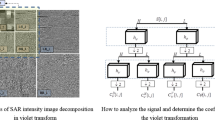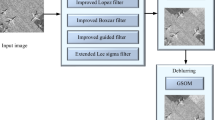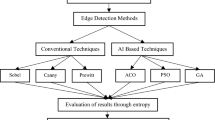Abstract
Interpretation of satellite radar images is an important ongoing research field in monitoring river ice for both scientific and operational communities. This research focus on the development of optimal recognition strategies for the purpose of identifying different ice classes in SAR imagery. However acquisitions of SAR images produce certain problems. SAR images contain speckle noise which is based on multiplicative noise or rayleigh noise. Speckle noise is the result of two phenomenons, first phenomenon is the coherent summation of the backscattered signals and other is the random interference of electromagnetic signals. This therefore degrades the appearance and quality of the captured images. Ultimately it reduces the performance of important techniques of image processing such as detection, segmentation, enhancement and classification etc. This research contributes the major objectives towards speckle filtering using wavelet techniques optimized by Ant Colony Optimization (ACO). First is to remove noise in uniform regions. Second is to preserve and enhance edges and image features and third is to provide a good visual appearance. The work is carried out in three stages. First stage is to transform the noisy image to a new space (frequency domain). Second stage is the manipulation of coefficients. Third is to transform the resultant coefficients back to the original space (spatial domain). Results show that statistical wavelet shrinkage filters are good in speckle reduction but they also lose important feature details. Here the challenge is to find an appropriate threshold value, which is achieved using intra-scale dependency of the wavelet coefficients to estimate the signal variance only using the homogeneous local neighboring coefficients. Moreover, to determine the homogeneous local neighboring coefficients, the ACO technique is used to classify the wavelet coefficients. Experimentation is conducted on SAR images which are further used for development of optimal recognition system for ice classes.
Access this chapter
Tax calculation will be finalised at checkout
Purchases are for personal use only
Preview
Unable to display preview. Download preview PDF.
Similar content being viewed by others
References
Zhang, H., Fritts, J., Goldman, S.: An Entropy-based Objective Evaluation Method for Image Segmentation. In: Storage and Retrieval Methods and Applications for Multimedia. Proceedings of the SPIE, vol. 5307, pp. 38–49 (2003)
Tweed, T., Miguet, S.: Automatic detection of regions in interest in mammographies based on a combined analysis of texture and histogram. In: International Conference on Pattern Recognition, Quebec City, Canada (August 2002)
Randen, T., Husoy, J.H.: Filtering for Texture Classification: A Comparative Study. IEEE Transaction on Pattern Analysis and Machine Intelligence 21(4), 291–310 (1999)
Tian, J., Yub, W., Mac, L.: AntShrink: Ant colony optimization for image shrinkage. Pattern Recognition Letters 31, 1751–1758 (2010)
Unser, M.: Texture Classification and Segmentation Using Wavelet Frames. IEEE Trans. on Image Processing 4(11), 1549–1560 (1995)
Wang, J., Li, J., Wiederhold, G.: Simplicity: Semantics-Sensitive Integrated Matching for Picture Libraries. IEEE Transactions on Pattern Analysis and Machine Intelligence 23(9), 947–963 (2001)
Liu, J., Yang, Y.-H.: Multi-resolution color Image segmentation. IEEE Transaction on Pattern Analysis and Machine Intelligence 16(7), 689–700 (1994)
Chan, R.H.: An Iterative procedure for removing random- valued impulse noise. IEEE Signal Process. Lett. (11) (2004)
Subashini, P., Krishnaveni, M., Ane, B.K., Roller, D.: An optimum threshold based segmentation for ice detection in SAR images using Gabor filter. In: Proceedings of International Conference on Computing, ICC 2010, New Delhi, December 27 - 28 (2010)
Abraham, A., Liu, H., Grosan, C., Xhafa, F.: Nature Inspired Metaheuristics for Grid Scheduling: Single and Multiobjective Optimization Approaches Metaheuristics for Scheduling: Distributed Computing Environments. SCI, pp. 247–272. Springer, Germany (2008) ISBN: 978-3-540-69260-7
Abraham, A., Grosan, C., Ramos, V.: Swarm Intelligence and Data Mining. SCI, p. 270. Springer, Germany (2006) ISBN: 3-540- 34955-3
Author information
Authors and Affiliations
Corresponding author
Editor information
Editors and Affiliations
Rights and permissions
Copyright information
© 2013 Springer-Verlag Berlin Heidelberg
About this paper
Cite this paper
Subashini, P., Krishnaveni, M., Ane, B.K., Roller, D. (2013). Wavelet Based Image Denoising Using Ant Colony Optimization Technique for Identifying Ice Classes in SAR Imagery. In: Snášel, V., Abraham, A., Corchado, E. (eds) Soft Computing Models in Industrial and Environmental Applications. Advances in Intelligent Systems and Computing, vol 188. Springer, Berlin, Heidelberg. https://doi.org/10.1007/978-3-642-32922-7_41
Download citation
DOI: https://doi.org/10.1007/978-3-642-32922-7_41
Publisher Name: Springer, Berlin, Heidelberg
Print ISBN: 978-3-642-32921-0
Online ISBN: 978-3-642-32922-7
eBook Packages: EngineeringEngineering (R0)




